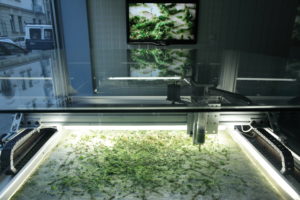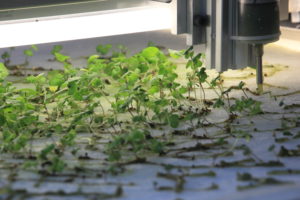Multidisciplinary Artwork by Seattle Artist Acquired by the Centre Pompidou for Its Permanent Collection
Artist Allison Kudla earned her PhD at the University of Washington and has exhibited nationally, as well as in Europe and Asia.
November 20, 2018
SEATTLE, WA—Seattle-based artist and designer Allison Kudla’s innovative living artwork “Capacity for (urban eden, human error)” was selected by the acquisitions committee of the Centre Pompidou, Paris, for acceptance into their Design and Industrial Prospects Collection. The piece will premiere at the Centre Pompidou on February 20, 2019, as part of the show “La Fabrique du Vivant”—the latest installment of the annual event “Mutations/Creations,” an exhibition and event series created in 2017 by Centre Pompidou’s president Serge Lasvignes. The show extends through April 2019.
“Capacity for (urban eden, human error)” is a novel work that straddles art, design, science and technology and presents itself in a performative format intended for a public audience. Acting as a large-format 3D printer, it extrudes living gel from which plants sprout. The computer-generated fractal it draws is based on the Eden growth model and uses mathematical representations of both urban growth and cellular growth, thereby connecting the concept of city with the concept of the organism. This system is working to make concrete the idea of dynamic and fluid computer space altering the expression and formation of a living and growing biological material, via its collaboration with an engineering mechanism.
“This is an incredible honor,” Kudla said. “I am grateful that Marie-Ange Brayer is a forward-thinking curator and recommended my work for acquisition. I am impressed by the design collection team and their willingness to do the work necessary to maintain and care for a living artwork. It gives me hope that museums will continue to be a place for generating new dialogues, presenting audiences with unexpected experiences and promoting cultural exchange at the cutting-edge.”
“This is an incredible honor,” Kudla said. “I am grateful that Marie-Ange Brayer is a forward-thinking curator and recommended my work for acquisition.”
Kudla began creating “Capacity for (urban eden, human error)” in 2007 while working as a PhD student in the first wave of the University of Washington DXARTS program. At the time, this program was unique for being the first in the U.S. to award a PhD for practice-based research in the arts.
The acquisition took seven months and was initiated by Brayer, the Centre Pompidou’s chief curator of design and industrial prospects, and assistant curator, Olivier Zeitoun. “Allison Kudla is an innovative multidisciplinary artist, combining biology, technology and design in a new and compelling way that audiences immediately connect with,” Brayer said. “This exciting work will enrich the Centre Pompidou’s permanent collection, and it will be presented in the exhibition ‘La Fabrique du Vivant,’ which examines the transformation of life in the age of biotechnology into art, design and architecture.”
“This exciting work will enrich the Centre Pompidou’s permanent collection, and it will be presented in the exhibition ‘La Fabrique du Vivant,’ which examines the transformation of life in the age of biotechnology into art, design and architecture.” Brayer said.
Brayer has actively worked to expand the design collection at the Centre Pompidou and organize exhibitions and events that enrich the museum’s commitment to innovation and the intersections of fine arts, sciences and industrial design. Brayer’s track record of support of multidisciplinary works has her continually on the cutting-edge of the field and ideally positioned to expand and celebrate the design collection of Centre Pompidou.
Centre Pompidou was established in Paris in 1977 by President Georges Pompidou with the originating mission of creating a “multidisciplinary cultural centre of an entirely new type.” The “Mutations/Creations” series, an event “decidedly turned towards the future and the interaction between digital technology and creation; a territory shared by art, innovation and science,” was created in 2017.
Accolades for “Capacity for (urban eden, human error)”
The completed version of the piece was presented in Linz, Austria for the Ars Electronica Festival 2010 as part of the show Repair sponsored by the OK Center and exhibited in the former Tabak Fabrik. It was exhibited in 2011 at the request of Jurij Krpan of Kapelica Gallery in Ljubljana, Slovenia. An earlier version of the piece was exhibited in New Orleans for the American Institute of Architects (AIA), DesCours Festival in 2007, curated and produced by Melissa Urcan. Additionally, it was shown at the Bumbershoot Festival in 2009 at the Seattle Center, curated by Lele Barnett and Chris Weber. From 2012-2014 it was part of a U.S. touring exhibit called Intimate Science, curated by Andrea Grover. With leadership from Grover and Astria Suparak, the exhibit was able to tour beyond Pittsburgh, Pennsylvania, and went to venues in San Francisco, California; Hartford, Connecticut; Pasadena, California; Lafayette, Louisiana; and New York City, New York. In 2015, it was presented at Globale: Exo-Evolution at ZKM in Karlsruhe, Germany, curated by Peter Weibel and Sabiha Keyif. In preparation for its travels to Germany it was presented at Common Area Maintenance (CAM) in Seattle. “Capacity for (urban eden, human error)” was selected for Honorary Mention in Hybrid Arts for Ars Electronica 2010. It also received Honorary Mention for Vida 13.0, the competition for Art and Artificial Life.
About Allison Kudla
Allison Kudla, PhD (U.S.), is an artist and designer who creates novel experiences at the intersections of science, art, technology and design. Since 2012, she has been working at the Institute for Systems Biology. Previously, she was an artist-in-residence and faculty member at the Srishti School of Art, Design and Technology in Bangalore, India. In 2011, she was awarded her Doctorate of Philosophy from the University of Washington’s Center for Digital Arts and Experimental Media (DXARTS). Her practice-based PhD focused on creating art for the purpose of looking at the universe as an operating system. With that lens, she pursued finding and accentuating “algorithms” embedded in living biological systems and processes within an artistic framework. In doing this, she creates time-based systems for experiencing biology working in hybrid with technology. Prior to her PhD work, she earned a BFA from the School of the Art Institute of Chicago, 2002, with an emphasis on art and technology studies. She lives in Seattle, Washington.


